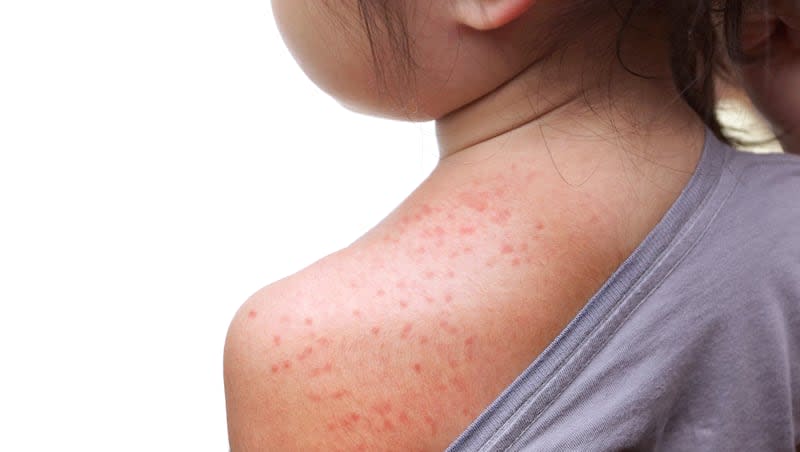Utah health officials worried about measles outbreak nearby

Utah‘s public health officials are concerned about the rising number of measles cases across the country, including in nearby Arizona. Monday, the Utah Department of Health and Human Services and the Salt Lake County Health Department issued a joint news release warning of a potential measles outbreak and encouraging parents to make sure their children are vaccinated.
While no cases have been reported so far in Utah, a public health spokesperson, Charla Haley, said there’s concern because the illness is very contagious and numbers are growing nationally. While 2023 saw 58 measles cases total, as of March 28, 97 cases have been reported across 17 U.S. states: Arizona, California, Florida, Georgia, Illinois, Indiana, Louisiana, Maryland, Michigan, Minnesota, Missouri, New Jersey, New York, Ohio, Pennsylvania, Virginia and Washington.
That’s an increase of 33 cases nationally in just the past week.
It’s not only the public who should be paying attention, either, Haley said. Doctors and other health care providers need to “be on the lookout. When someone comes in, make sure you recognize it. So many people, including doctors, have never seen measles before.”
That’s because measles was declared eliminated in 2000, according to the Centers for Disease Control and Prevention, since two-dose vaccination is 97% effective against the viral illness. But the CDC reports that “declines in measles vaccination rates globally have increased the risk of measles outbreaks worldwide, including in the United States. Measles cases continue to be brought into the U.S. by travelers who are infected while in other countries. As a result, measles outbreaks have been reported in most years.”
The bulk of imported cases come from unvaccinated U.S. citizens, per the CDC. Health officials estimate that if one person gets measles, 9 of 10 people around that person who have not been vaccinated will get it. And there’s a lag time of 10 days to two weeks between exposure and symptoms, so people can unknowingly transmit the illness to others.
Haley said measles is a disease that doctors must report to public health officials within 24 hours.
The CDC said there have been seven outbreaks of three or more related cases so far this year and nearly three-fourths of the cases are outbreak-related. In 2023, there were four outbreaks. Fifty-four of the 97 people so far diagnosed with measles this year have been hospitalized to manage complications or for isolation, including 68% of cases among children under age 5, 27% of cases among those ages 5 to 19, and 56% of cases among those 20 and older. Fifty of the cases involved very young children.
Utah health officials are asking people to check immunization and medical records or talk to their health care provider to make sure they are protected from measles. That’s particularly important for people who are planning to travel out of state. Folks can request their immunization record at https://immunize.utah.gov/usiis-parents-individuals/. Records can also be seen in the Docket app or online.
Measles misery
While most people who get measles experience a high fever (up to 105 degrees Fahrenheit) and a rash, unvaccinated young children, pregnant women and those with a compromised immune system in particular can have more serious illness, including diarrhea, ear infections, pneumonia, brain infection, seizures and even death.
“The (measles, mumps, rubella) MMR vaccine has been used since the early 1970s and has saved millions of lives — and prevented significant suffering — around the globe,” said Leisha Nolen, state epidemiologist at the Utah Department of Health and Human Services. “The MMR vaccine is safe and effective. Decades of careful research has shown the benefits of being vaccinated against measles far outweigh any risks the vaccine may pose.”
She said that babies can develop a mild fever after vaccination, while adults often have a sore arm. “More serious reactions, like severe allergic responses, are extremely rare and can be treated.”
Haley said a single-dose of the MMR vaccine is roughly 93% effective at preventing measles and the second dose brings it to about 97%. “It only takes a few days for antibodies to develop in response to the MMR vaccine. Within two to three weeks, the immune system is fully primed after vaccination,” she said.
Health experts say herd immunity, which significantly reduces spread of a contagious illness, is achieved when more than 95% of people are vaccinated. But vaccination of U.S. kindergartners has fallen from 95.2% during the 2019-20 school year nationally to 93.1% in the 2022-23 school year — the last one with full data.
In Utah, about 90% of children in kindergarten had been vaccinated in 2022-23. In three neighboring states, coverage was less than 90%: Idaho (81.3%), Colorado (87%) and (Arizona (89.9%), based on CDC estimates. New Mexico fell just short of herd immunity rates, at 94.9%, while Nevada and Wyoming were in the low 90% range.

